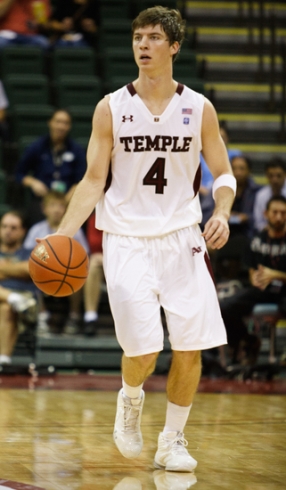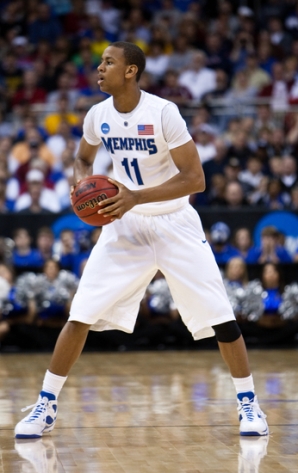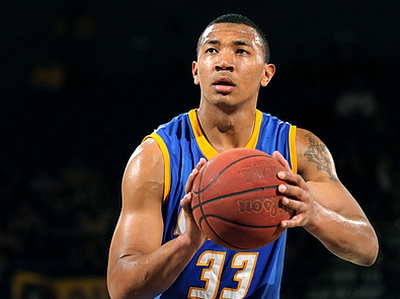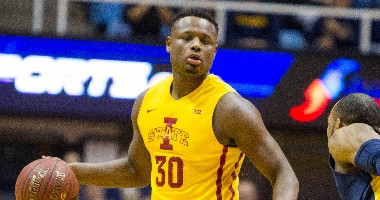Freshmen have been excluded from these previews, as we'd like to wait and see what they have to offer on the NCAA circuit before we come to any long-term conclusions.
-Top 20 Prospects in the Big Ten
-Top 25 Prospects in the ACC
-Top 15 Prospects in the Big 12
-Top 15 Prospects in the Pac-12
-Top 25 Prospects in the Big East
-Top 15 NBA Prospects in the SEC
-Top NBA Draft Prospects in the Non-BCS Conferences, Part One (#1-5)
-Top NBA Draft Prospects in the Non-BCS Conferences, Part Two (#6-10)
#11 Orlando Johnson, 6-5, Senior, SG, UC-Santa Barbara
Having profiled Johnson last season with a comprehensive scouting report, we've elected to wait and see what type of progress he's made with a fresh perspective in a few months, rather than rehashing many of the same comments made last year based off his 2010-2011 game footage.
#12 Drew Gordon, 6-9, Senior, PF, New Mexico

Joey Whelan
After a tumultuous year and a half at UCLA where alleged conduct detrimental to the team, led to a mutual parting, former McDonald's All-American Drew Gordon seems to have finally found his niche at New Mexico after becoming eligible last fall.
In his first season with the Lobos, the power forward was named Mountain West Conference Newcomer of the Year after posting a terrific line of 18.3 points and 14.8 rebounds per-40 minutes adjusted on 52.7% shooting. The pundits are expecting even bigger things from the senior as he has been tabbed MWC Preseason Player of the Year, with New Mexico the favorite to finish on top of the standings.
Gordon certainly passes the eye test for a power forward in the NBA. At 6-foot-9, 245 pounds, he has the bulk and strength to handle the rigors of life in the paint, but also the length and intensity to make his presence felt around the rim. Not terribly explosive vertically, Gordon's timing, aggressiveness, soft hands and nose for the ball are what make him the second best returning rebounder per-40 minutes pace adjusted in our database.
The offensive book on Gordon is a pretty simple one: 89.5% of his shot attempts last season were attempted in the paint according to Synergy Sports Technology. He has a solid base, does an excellent job of establishing position, seals well and displays good touch, all traits scouts like to see from post players.
While clearly a load for opposing MWC teams to handle inside the paint, Gordon isn't terribly efficient as a post-up scorer (.859 points per possession on 41% shooting), which is largely due to his lack of explosiveness.
Despite his soft hands, nimble footwork and good touch, Gordon doesn't do a good job of adapting to the defense. On many possessions it seems as though he determines what he'll do before the basketball is ever delivered, and then follows through regardless of what his defender does or what the angle is. This isn't rare amongst players who were forced to sit out an entire year as Gordon was after transferring from UCLA, so it will be interesting to see how he looks in a full season of action.
As things stand, his back-to-the-basket arsenal includes a nicely developing baby hook along with a solid drop stepbut if unable to simply bully his way to the rim, he just isn't always able to elevate over defenders and finish plays.
While his back to the basket game is unlikely to translate to the highest levels of competition, he's able to score in other waysthrough his work on the offensive glass, moving without the ball and as a pick and roll finisher.
Outside of the paint, Gordon's game is a work in progresshe converted 8 of 25 jumpers according to Synergy Sports Tech. The good news is he doesn't seem to be that far off from being a consistent threat as a mid-range option, something that would definitely give his NBA prospects a boost.
Of the handful of jumpers he did take last season, the bulk came from foul line extended when he rotated behind an attack guard as a safety valve. His shooting form is relatively smooth, just inconsistent in that he tends to not fully extend on his release, leaving the shot short. His free throw shooting marks have improved each year as well (last year: 68%), which is a positive sign.
Gordon rarely will attack off the dribble from the high post, but when he does, things tend to go array if it's anything beyond a one dribble move to the rim.
Improving his shooting and ball-handling skills will be important as he makes the transition from collegiate center to the power forward position, something that will be necessary considering his height.
Defensively, Gordon is mostly a mixed bag at this point, showing both strengths and weaknesses.
He isn't terribly effective defending opposing big men inside the paint, as he gives up post position very easily and shows average toughness and awareness.
Away from the basket, though, Gordon does well defending face-up forwards, showing solid lateral quickness and relying on an above average wingspan to recover effectively and challenge shots inside the paint.
Gordon is an interesting prospect who still needs to show quite a bit in his final season in order to secure a spot in the NBA. What was once a very promising career has obviously taken some unique turns, but he seems to finally be reaching a point he seemed destined to following high school. There's no denying his rebounding prowess and his scoring instincts, but he needs to become a more consistent shooter and low-post defender in order to improve his pro prospects.
The book is still very much out on Gordon, but another season in which he averages a double-double while leading his team to the NCAA tournament would go a long way in helping his cause.
#13 Deonte Burton, 6'1, Sophomore, Point Guard, Nevada

Matt Williams
A largely unheralded recruit coming out of Centennial HS in Compton, Deonte Burton had a tremendous freshman year at Nevada, garnering WAC Freshman of the Year honors. He did not stand out in any one particular area, but made an immediate impact for the Wolfpack, and will be a key part of the success of what will be one of the more talented teams Nevada has had in some time as a sophomore. Considering what he was able to accomplish as a true freshman, Burton is a prospect worth keeping an eye on as he looks to take a step forward in his sophomore year.
Athletically, Burton fits the profile of a NBA point guard fairly well. He isn't overwhelmingly quick or explosive, but he has a nice first step, a frame that still has potential for growth, and will surprise defenders with his ability to rise up and play above the rim when he jumps off of two feet. Like many freshmen, he could stand to slow down and become a bit more discerning with the way he utilizes his athleticism as he gets a bit out of control at times, especially in traffic.
As a scorer, Burton makes an impact on a number of levels. He can score on the pick and roll thanks to his ability to turn the corner and finish at the rim, will knock down spot-up shots from beyond the arc with consistency, and shows the ability to create separation for pull-up jump shots seamlessly from the midrange in one-on-one situations.
Though his shot selection is less than ideal and he often shoots the ball on the way down when defended, Burton takes and makes a lot of difficult jump shots. He only knocks down 30% of his pull-up jump shots according to Synergy Sports Technology, but his 45% shooting with a hand in his face off the catch is nothing short of impressive. Clearly there's a bit of a gap in his efficiency from the perimeter, and balancing his spot-up and midrange shot selection is a sticking point in Burton's offensive development moving forward.
In some ways, something similar can be said regarding Burton's slashing ability. He does a tremendous job drawing contact and getting to the line, but his propensity to play too fast when attacking the paint leads to some erratic shots around the rim and when pushing the ball in transition. Though he doesn't settle for many floaters, Burton needs to learn to improve his decision-making and play at different speeds to maximize his efficiency in the paint.
As a point guard, Burton does a nice job making the easy plays to set up his teammates when he sees an opportunity, but has plenty of room to grow and the tools to improve. Considering his shot selection, Burton could be deemed a tweener at this point, but he juggled his role as point guard and scorer fairly well for a freshman and if he begins to be a bit less aggressive with his jump shot and plays more under control off the dribble and with pace in transition, his ability to distort defenses and push the tempo could help him emerge as a quality playmaker.
Defensively, Burton plays with good energy. He shows tremendous recovery speed when closing out shooters, but is a bit overaggressive at times, allows slower players to get to the rim in one-on-one situations, and doesn't always fight aggressively over screens. Still, he shows solid intensity and with time and coaching could become a capable defender thanks to his solid lateral quickness.
Deonte Burton may have his shortcomings as a prospect at this time, but there are few players who are able to come into the college game and have an immediate impact akin to the one he had last season. Considering Nevada returns much of its core this season, Burton's role may not radically change this season, but if he makes some incremental improvements, considering the amount of time he has to develop, he could become one of the more intriguing mid-major guard prospects in the west in time.
#14 Juan Fernandez, 6'4, Senior, Point Guard, Temple

Jeff Rush
Despite some late heroics in the NCAA Tournament to get the Temple Owls out of the Round of 64 against Penn State, Juan Fernandez took a major step back in his junior season. Fernandez's shooting percentage dropped across the board, including a staggering 12% from the three-point line in a similar number of attempts to the year before. This sizeable drop is interesting because Temple returned most of the important pieces from their 2009-10 team, and it did not appear that we can blame his inefficiency on a change in expectations or his role.
A knee injury and a loss of confidence due to being cut from the Argentinean national team during the summer are typically the two main reasons offered, so it will be interesting to see how he bounces back this season.
At 6'4, Fernandez has very good size for the point guard position, but does not possess the type of athleticism that you look for in your prototypical NBA guard. He makes up for his lack of explosive athletic ability with an advanced feel for the game and a number of crafty moves that allow him to get his shot off against taller and longer players. He also does a good job of playing at different speeds which helps make up for his lack of explosiveness. How much that would translate to the NBA remains to be seen, but he clearly has a lot to offer as far as the college game is concerned.
Fernandez has a somewhat awkward release on his shot in part because of the fact that he often does not get his feet set properly underneath him when he is shooting, but also because of the variety of ways that he gets his shot off against more athletic defenders. Both of those factors limited his consistency last season, but didn't prevent him from shooting 45% from beyond the arc as a sophomore.
Despite his sometimes erratic shooting, Fernandez is adept at creating space nonetheless by thanks to his very versatile in-between game coming off of ball screens. He has a nice repertoire of pull-up jump shots and runners that he uses effectively and will even go all the way to the basket at times to keep the defense honest in guarding him. He hasn't been particularly efficient scoring inside the arc at any point in his career, though, never exceeding 40% from 2-point range at his peak, which is a very poor rate. He doesn't get to the free throw line at a high rate to compensate either.
Fernandez is not the most traditional point guard, but he does show a very solid feel for the game. He is a very good passer off of the dribble, using ball screens and finding rollers, spot up shooters, and cutters through traffic in the lane. That being said, he only averaged 5.0 assists per 40 minutes pace adjusted which puts him behind many of the other point guard prospects in his class nationally, several of which are considered more scorer than distributor. His 1.83 assist-to-turnover is solid, but is improvable considering the pace Fernandez plays at.
Defensively, Fernandez will always be at a disadvantage considering his average athleticism, but is smart enough to know how to compensate. He lacks the strength and quickness to get through screens at times, which forces him to go underneath at give up open 16'-20' looks for the player he's guarding. He is smart though and does a good job playing angles and seeing openings that the offense tries to exploit and covering them up. He will never be considered a lock down defender, and certainly would struggle guarding the world class athletes that he would see at the next level, but like every other part of his game, he has developed ways to make up for his deficiencies.
Heading into his senior year, Fernandez has a lot of questions to answer that will give us a better picture of what level we will see him playing at in the future. The first of which will be about his drop off in his shooting in his junior year. If it is just a blip on the radar he may be able to prove that he is capable of developing into the type of player that can make up for his lack of athleticism by being able to spread the floor and play smart basketball.
#15 Wesley Witherspoon 6'8, SF/PF, Senior, Memphis

Kyle Nelson
Wesley Witherspoon's career at Memphis has been a series of dramatic highs and lows. Coming off of an impressive sophomore season where he emerged as one of the nation's most versatile players, few thought that he would stay past his junior year. A disastrous junior campaign temporarily derailed his NBA hopes, however, as he now he looks to bounce back as a senior and lead a talented, but inexperienced Memphis team to an NCAA Tournament run.
From a physical perspective, there is little else to say about Witherspoon that has not already been said. He passes the eye test and then some, with excellent size for the perimeter at 6'9 and his long wingspan, but he has failed to significantly improve his skinny 209-pound frame since arriving at Memphis. While he is not an elite athlete by any measure and he struggled through injuries as a junior, he is best described as fluid and most likely around average at the next level.
What changed significantly since we last wrote about Witherspoon has been his role on the offensive end of the floor. For one, he averaged just nine points per game as a junior, which is only 15.1 points per 40 minutes pace adjusted. That being said, while his possessions dropped significantly, he actually developed into a more efficient scorer.
According to Synergy Sports Tech, most of Witherspoon's possessions come as a spot-up shooter. By the numbers, he once again had a solid year, making 40% of his 2.5 attempts per 40 minutes pace adjusted. His mechanics are a tad compact and his release point could be higher, but he seems to have found the shooting touch that he lacked as a freshman, albeit in a limited sample size. He also showed an increased willingness to utilize screens in order to get open in catch-and-shoot from mid-range. That being said, he still struggles to get his shot off if not left open, making just one of his 14 guarded attempts according to Synergy.
He shows some ability to operate solo from mid-range, as well, showcasing solid ball handling abilities relative to his size and a nice pull-up jump shot that he utilized at times.
Operating as a face-up power forward for Memphis, Witherspoon is a solid mismatch threat attacking defenders with his straight line dribble, getting to the free throw line at a nice rate. He isn't very effective when forced to change directions with the ball, however, as he still exclusively drives left and he is still far too weak to withstand or finish through contact around the basket. Furthermore, he continued to display a propensity to develop tunnel vision off of the dribble, which resulted in turnovers and bad decisions.
He regressed on the offensive end as a junior, so scouts will be watching to see if he can earn minutes a far deeper backcourt rotation by continuing to score efficiently while making better decisions with the ball.
Though he still uses his length well to interrupt passing lanes, Witherspoon is a poor defender due to his average lateral quickness and physical toughness. He's typically very upright in his stance, making it difficult for him to stay in front of quicker perimeter players. This is an area he'll have to show better potential in to prove he can guard small forwards in the NBA. While Witherspoon can adequately stay with Conference USA's plethora of undersized power forwards, he usually struggles when matched up with more talented players because of his lack of strength, mobility and toughness.
While all indications are that he's healthy and that he is entering his senior season with a renewed focus, Witherspoon will likely come off of the bench for the second consecutive season. He will be competing for minutes in a talented backcourt including Joe Jackson, Will Barton, and Adonis Thomas, so it would not be surprising if he once again operates as a face-up 4. Regardless of position, Witherspoon will need to emerge as a veteran leader for Memphis while continuing to make shots and get to the free throw line, as well as show that he can defend his position adequately to attract the interest of NBA scouts.




































Comments